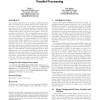Free Online Productivity Tools
i2Speak
i2Symbol
i2OCR
iTex2Img
iWeb2Print
iWeb2Shot
i2Type
iPdf2Split
iPdf2Merge
i2Bopomofo
i2Arabic
i2Style
i2Image
i2PDF
iLatex2Rtf
Sci2ools
SIGCOMM
2009
ACM
2009
ACM
Optimizing the BSD routing system for parallel processing
The routing architecture of the original 4.4BSD [3] kernel has been deployed successfully without major design modification for over 15 years. In the unified routing architecture, layer-3 (L3) IP routes are maintained with layer-2 (L2) ARP entries in the same kernel structures. This meant that a single table lookup can return both results. Today, the prevalence of multi-core CPUs and parallel processor architectures is driving the re-design of software data structures and control flows to fully exploit the parallel capabilities of commodity hardware. A common parallel TCP/IP network protocol stack design separates out L2 and L3 processing from layer-4 (L4) and layer-5 (L5) (TCP and socket) onto different CPU cores. The unified routing architecture creates data dependencies between these layers, complicating the design and causing high levels of lock contention. In this paper we will detail the routing architecture that we have implemented for the upcoming FreeBSD 8.0 kernel, whic...
Communications | Network Protocol Stacks | Routing Architecture | SIGCOMM 2009 | Unified Routing Architecture |
| Added | 28 May 2010 |
| Updated | 28 May 2010 |
| Type | Conference |
| Year | 2009 |
| Where | SIGCOMM |
| Authors | Qing Li, Kip Macy |
Comments (0)

